According to the Philippine Statistics Authority, in 2019, the tourism industry’s contribution to the country’s Gross Domestic Product (GDP) was 12.7%, equivalent to ₱2.48 trillion—over 10% higher than that of the previous year. But when the pandemic hit in 2020, this was reduced to more than half at only 5.4%. In February this year, Department of Tourism (DOT) Secretary Bernadette Romulo-Puyat said that 4.8 Filipinos working in the tourism sector were affected by the pandemic.
But now that restrictions are easing in most parts of the country, DOT is reviving the country’s tourism. “One advantage in the Philippines is that we have a wide domestic tourism base,” shared DOT Usec. Benito Bengzon Jr. in a mix of Filipino and English during a Panayam sa Panahon TV interview. “We don’t solely depend on foreign visitors. Filipinos themselves can help boost our economy. So, we call on our fellow Filipinos to support the reopening of travel destinations while following health and safety protocols.”
 Wearing a face mask and face shield is a must during traveling. (photo by Lorna Mamaril)
Wearing a face mask and face shield is a must during traveling. (photo by Lorna Mamaril)
How you can travel during the pandemic
As the Department of Health (DOH) continues to record daily new cases by the thousands, and with the emergence of deadlier and more transmissible variants, is it really safe to travel during this time? Usec. Bengzon assured the public that DOT consulted with DOH before restarting the travel industry. “We also listened to the pleas of those who lost their jobs—and this is one of the reasons why we’re doing this. We made sure that the 2reopened destinations are in areas which have contained COVID-19, or have low case counts. All these tourism enterprises have health and safety protocols—not only in their accommodations, but also among tour operators and in tour buses, restaurants, and convention facilities.”
According to Usec. Bengzon, the government also made traveling more convenient with the following initiatives:
- Uniform travel requirements
Because travelers complained about different travel requirements from local government units (LGUs), the Inter-Agency Task Force (IATF) streamlined the protocols. Right now, the only requirement is a negative RT-PCR test. But because situations may change any time, www.philippines.travel provides a list of destinations, their quarantine statuses and particular travel requirements. As of writing, Baguio City welcomes fully vaccinated tourists without the COVID-19 test. “Areas under MGCQ (modified general community quarantine) or GCQ (general community quarantine) are allowed to open their destinations, but if their LGUs don’t want to accept tourists, then that is something we respect,” said Usec. Bengzon.
- Subsidized RT-PCR tests for local tourists
The DOH’s advisory on the price range of RT-PCR testing is a maximum price cap of ₱5,000 for private laboratories, and ₱3,800 for public laboratories. Since this is a must before traveling, the DOT released ₱35.17 million this year to fund 50% of the testing cost for domestic travelers who have confirmed round-trip transportation tickets and a booking confirmation with a DOT-accredited accommodation establishment. Done in partnership with the Philippine General Hospital and the Philippine Children’s Medical Center, Filipino tourists can apply for the subsidy program through this website.
- No age restriction
Filipino of all ages are now allowed to travel. “Before, those below 18 and over 65 years old weren’t allowed to travel,” recalled Usec. Bengzon. “We had to adjust because we all know that when Filipinos travel, they bring the whole family.” Still, all members including infants are required to undergo RT-PCR testing.
- Lessened quarantine period for those entering the Philippines
Recently, the IATF announced that fully vaccinated travelers from “green” countries entering the Philippines now have a lessened quarantine period of 7 days from the previously required 10 days. “Green” countries are “classified by the DOH as low-risk countries or jurisdictions based on disease incidence rate.” Currently, the 57 countries and jurisdictions include:
Albania
American Samoa
Anguilla
Antigua and Barbuda
Australia
Benin
Belize
The British Virgin Islands
Brunei
Burkina Faso
Burundi
Cayman Islands
Chad
China
Cote d’ Ivoire (Ivory Coast)
Eswatini
Falkland Islands
French Polynesia
Gambia
Ghana
Greenland
Grenada
Hong Kong
Iceland
Isle of Man
Israel
Laos
Liberia
Malawi
Malta
Marshall Islands
Mauritius
Micronesia
Montserrat
Morocco
Mozambique
New Caledonia
New Zealand
Niger
Nigeria
Northern Mariana Islands
Palau
Rwanda
Saba
Saint Barthelemy
Saint Kitts and Nevis
Saint Pierre and Miquelon
Sierra Leone
Senegal
Singapore
Sint Eustatius
South Korea
Taiwan
Togo
Turks and Caicos Islands (UK)
Vietnam
Zimbabwe
 IATF now allows children below 18 years old to travel. (Photo by Blueberrie Recto)
IATF now allows children below 18 years old to travel. (Photo by Blueberrie Recto)
Ensuring travel safety
Based on a DOT survey conducted last year, Usec. Bengzon stated that the top destinations Filipinos want to visit when restrictions eased were Boracay and Palawan. But top results also included road trip and staycation destinations. Now that leisure travel is allowed, Usec. Bengzon offered these safety tips:
- Follow minimum public health standards.
“We say this over and over, but this is the most important. We should comply by wearing our face masks and face shields, and by practicing frequent handwashing and physical distancing.” In turn, tourism establishments should also follow strict health and safety protocols. “These protocols were actually crafted by the Department of Tourism,” shared Bengzon. “Secretary Bernadette Romulo-Puyat instructed us to craft safety protocols to ensure everyone’s safety—from tourists and tourism employees to local communities.”
- Conduct transactions online.
To minimize face-to-face contact, accommodations encourage online transactions such as reservation and registration. To reduce the risk of infections, front desks and restaurants are equipped with glass or acrylic partitions. Hotels also limit the number of occupants in a room, depending on its size.
- Allot enough time for planning your trip.
Because traveling during the pandemic requires additional logistics, Usec. Bengzon advised giving yourself enough time to prepare. “If there’s one good thing that came from this pandemic, it’s that we’ve become disciplined in doing our research and making plans. Read up on your destination and its travel requirements. Use technology to your advantage when getting information and making reservations. When moving around the different destinations, cooperate and be patient.”
Helping the travel industry
Technology has also helped travel agency owner, John Paull Belleca, in pivoting his business called Travelleca. “Since the pandemic, we shifted to conducting our business online for the safety of our employees and clients. The good thing about that was we were able to provide 24/7 services, and even grow our market.” Aside from preparing itineraries, Travelleca also assists in securing travel requirements such as swab testing and passport renewals.
But despite the ease in restrictions, Belleca confessed that his business has yet to fully recover. For struggling travel agencies like his, Usec. Bengzon said that the DOT has prepared a 6-billion peso budget to be used by tourism enterprises for their capital loans. “The terms and conditions are very friendly. The loans don’t require collateral or interest. Businesses only need to pay a service fee.” The loan period is up to 4 years, with a grace period of up to 2 years. “For those who lost their jobs related to tourism, we have a program with the Department of Labor and Employment (DOLE), which allotted ₱3 billion for cash assistance.”
Right now, the DOT continues its training of tourism frontliners on the Filipino brand of hospitality, and helping destinations in their branding, marketing, and events using virtual platforms.
 Passport assistance services help travel agencies like Travelleca stay afloat during the pandemic. (photo from Travelleca’s Facebook page)
Passport assistance services help travel agencies like Travelleca stay afloat during the pandemic. (photo from Travelleca’s Facebook page)
Is it really safe to travel during the pandemic?
Though pandemic travel still has its risks, Usec. Bengzon believes that it is matter of balancing health and safety protocols with the need to restart an industry that provides millions of jobs to Filipinos. “We know that tourism significantly contributes to our economy. If we cooperate, and with patience and understanding, we’re confident that we can revive our country’s travel industry.”
Still, the ball is in the Filipinos’ court. Whether they choose to travel or not depends on their risk appetite—as well as the country’s pandemic recovery. As Belleca put it, “I think herd immunity is also one of the keys in reviving tourism. This will also ease our fellow Filipinos’ fear of COVID-19.”
Watch the full the interview here.
Panayam sa Panahon TV airs every Tuesday at 5 p.m. on Panahon TV’s Facebook page.
Toulouse, the capital of the Occitanie region in Southern France, is rich in history and culture. It was part of the Roman empire until the 5th century, and is now known for its aerospace industry, housing Europe’s largest aerospace center, including the French space agency.
It had a huge role in the history of Catholicism. It is where Romans persecuted early Christians and martyred a saint, and the site of a religious riot that started the French Wars of Religion. Toulouse became the templar stronghold in the first crusades, and Saint Dominic founded the Dominican Order here. Currently, it is home to several cathedrals, including the UNESCO World Heritage Site, the Basilica of St. Sernin, Europe’s largest surviving Romanesque building.
Toulouse is France’s fourth-largest city, whose center’s architecture is mainly composed of terracotta bricks, earning it the title, “The Pink City”. This is where we find Marjorie Mosura-Dumont, who has been residing here for 3 years.
 Marjorie and Henri strolling in town before the nationwide lockdown during COVID-19
Marjorie and Henri strolling in town before the nationwide lockdown during COVID-19
After marrying Henri, my French fiancé, I moved to Paris in 2010. I loved Paris because of its beautiful architecture and buildings, but after a year, he said he was tired of its gloomy weather and gloomy people. We agreed to move to the Philippines slowly by backpacking from Paris to India, Nepal, and other countries between there and Manila.
After living in Metro Manila for five years, a lot of factors led us to decide to return to France. His nuclear family came from the north but decided to settle in the south of France, including his brother who was based in Toulouse, so we chose to live here.
Toulouse vs Paris
Toulouse is in the southwest of France, close to the Pyrenees and the Mediterranean Sea. This is perfect for us because we love hiking, and we once trekked all the way to Spain. It’s one of the stops in the Camino de Santiago or the Way of Saint James, which is a pilgrimage you do on foot for a month. We’re also conveniently close to another pilgrimage site called Lourdes.
 Marjorie hiking to Lac d’Espingo in Pyrenees
Marjorie hiking to Lac d’Espingo in Pyrenees
The city has a distinct architecture and it looks magical a few hours before sunset. It’s well known for its terra-cotta bricks that glow pinkish-orange.
In terms of museums, Paris has the upper hand. Museums here are few, and mostly house roman and medieval pieces. The theater scene here is also limited, but it feels more intimate.
History is a huge part of Toulouse, which is the birthplace of Aeropostale. After World War I, the post service company delivered mail from Toulouse to different parts of the world, including Casablanca and South America. The flights were a big deal because before then, mail traveled only by boat. Because of Aeropostale, French colonies received mail much faster.
Aeropostale flights could be dangerous—something which Antoine de Saint-Exupéry, the author of The Little Prince wrote about in his novel Vol de Nuit (Night Flight). Saint-Exupéry was an Aeropostale pilot, so The Little Prince was his semi-biography. Some streets here in Toulouse are named after him.
Through the years, Toulouse has retained its “aero center” status. Now, it’s famous for developing and building technology for the aerospace industry. One of the museums here is dedicated to outer space travel. The Airbus planes are also built here, which explains why there are a lot of engineers and expats in Toulouse. We also have a good amount of Irish pubs for some reason, with real Irish bands playing to boot!
Where the old Aeropostale airport used to be is now where you can find the La Halle De La Machine’s giant mechanical minotaur and spider. I shot a report for a news agency when they launched it a few years back. The minotaur and the spider walked all around old Toulouse for three days and it was a sight to see! Roads were closed, people ran after it, I saw a grown adult cry. I hung from a hotel window at the main square with photographers to take video of all that happening. It was other-worldly, but it was the magic of engineering, music and imagination.
A lot of people like it here because it’s warmer and less rainy than Paris, and the vibe is more chill. It’s France but a little Basque. The locals like drinking, partying, and going to tapas bars. We live a few minutes by foot from the Garonne River and the historic center, and we can walk to our favorite bar across the Pont Neuf bridge. Before the pandemic, we used to drink at the bridge and enjoy the music spilling from the bar. When our drinks ran out, we’d just duck back in for refills and rush right out into the fresh air. There seemed to be an unwritten agreement for the whole city to be out at five. I think that’s the best image I could draw for you about life here—seeing your friends, having a drink and watching the glow of the sun set on the pink city.
Toulouse and COVID-19
At the start of the quarantine in March, we had to print out a form indicating the date and time we left our home. For example, I’m going out on this date: March 11, from 1 to 2 p.m. We only had an hour to jog or walk the dog within a 1 kilometer radius from our address. Two household members at a time could go out of the house. For a time, the restaurants were closed, and the lines at the supermarkets were very long. Only ten people at a time could enter. But at least we were still allowed to walk and stretch outside, that helped manage my anxiety.
Back then we didn’t have a lot of cases in Toulouse, but there was still a shortage of face masks and they were very expensive. I made masks for a friend who is a nurse so she could distribute them at her hospital. She said other hotspots flew their patients here because our hospitals had a lot of empty beds. It was only last August when the government required face masks in the streets. Before that, we were only required to wear them in stores. In July, travel restrictions were lifted because the cases went down, and it’s too much to ask the French to stay at home during summer.
But things have changed after summer. We’re now one of the hotspots for COVID cases. We had a curfew for a few weeks and then the government decided to close the bars, restaurants and activity areas to prevent the spread of the disease. A lot of businesses closed down despite some monetary help from the government because they were still paying rent for shops that can’t open.
Despite the health crisis, what’s good about living in France is its universal healthcare. When I had a pulmonary embolism two years ago, the firemen came at 5 a.m. and took me to the hospital. I waited for my bill in the mail but nothing came! Henri and I try not to go to the doctor for every little thing to avoid overtaxing the system. Socialism is awesome only if everybody’s truly egalitarian. As a member of the middle class in the Philippines, it sucked to pay so much in taxes and get nothing in return when we needed money to treat my dad’s cancer.
Pinay in Toulouse
Toulouse is a rich melting pot. I have friends from many different countries that I would never have met if I didn’t go to my state-sponsored French classes. Thanks to them, I’ve learned a lot of fascinating things about life in South Africa, Syria, Turkey, Mexico, and the Ukraine (just to name very very few). On my end, I’ve introduced them to Pinoy food.
At first, it was hard to adjust to the fact that there were no Pinoy stores here, unlike Paris that has at least two. After early evening mass at St. Joseph’s Church near the Champs Elysees in Paris, there’s a Pinoy palengke at the church steps. In my first 4 months of living here, I didn’t hear anyone speaking Tagalog.
Then one time, I was at an Asian supermarket with my Vietnamese friend and I heard someone speaking in Cebuano. So I called out: “Ate, Pinoy kayo?” She said,“Oo!” It was comforting to know I had kababayans here. If you want ensaymada, pan de coco, or sapin-sapin I have connections. There may be no Pinoy store here, but there are enterprising Pinoys who make and sell native treats.
Here, I started painting again. My dad was a frustrated comic book artist, and one of the most precious gifts he gave me were art supplies. We used to bond over drawing things and he wanted me to be an artist, but I became a writer like my mom. When I got here, I started painting Filipino food just because I missed them. And I know I could have gotten a rambutan from a specialty store but I felt guilty and privileged about the contributing to the carbon footprint of one measly rambutan that isn’t really necessary for my survival. I just missed it, but I guess most of all I missed the context of it. So when I finished painting I threw in the baybayin script under the artwork to make it plain that I’m talking about this food as a Filipina, with the context it has as a thing you can see in the palengke or hanging in a tree, with the common experiences we have around it that nobody else might immediately understand, but give me a minute to tell you its story.
 Marjorie’s adobo painting sticker with a background of a fortified city from the dark ages
Marjorie’s adobo painting sticker with a background of a fortified city from the dark ages
I’m part of a small painting community with five other Filipina friends. My friends have encouraged me to branch out into landscapes and flowers. I’ve tried that but I’ve mostly dug in my heels with Pinoy subjects. I started an Instagram account and (more recently) a website to share what I’m doing and reach out to people who are missing the same things I have. I’ve met some interesting people this way. I used to print my paintings on sticker paper and stuck them on random spaces around Europe. I thought about it as a way to teach my culture to anyone who would bother to look at what’s written under the painting of a tomato, for example. But if a Pinoy saw one, my hope is that they would realize that a fellow Pinoy passed through there, and that they’re not alone.
All in all, I like living here. Henri and I have always wanted to live in a place where we can grow things and here we get a lot of sun. For now we have an edible garden on our apartment balcony. So far, I’ve managed to grow calamansi, which I got from IKEA two years ago. Henri and I laughed about it then because they think it’s ornamental, but to me it was like the heavens opened. However, I think the age of innocence is at an end because Henri saw a fancy specialty store selling calamansi a month ago.
 Marjorie’s calamansi harvest from her edible garden
Marjorie’s calamansi harvest from her edible garden
The thing is, we want to be self-sustaining. Eventually, we want to be able to recycle water and use renewable energy. We want to reduce our carbon footprint. But for now, Toulouse fits our purpose, and I’m soaking in its laid-back vibe, allowing it to fuel my Pinoy-inspired art, wherever it takes me.
We cannot deny that social media plays a huge role in our lives more so during this pandemic. In the absence of face-to-face interaction, Facebook, Instagram, Twitter provide safe and convenient ways for us to connect with family, friends and even work colleagues. Social media updates us on the events in each other’s lives without having to initiate contact and ask “How are you?” Such information is freely shared and available through a mere tap of a finger.
But too much of a good thing may lead to problems. Though virtual interaction may be beneficial to our mental health during the pandemic, mindless scrolling of social media feeds can lead to sadness, loneliness and even exhaustion. Because mobility and activities are currently limited, such emotions may push us to simply pick up the smartphone and indulge in another round of scrolling. To better care for our mental health, we need to break this cycle.
What is social media detoxification?
According to Itin Lachica-Umali, a Psychology professor at the Colegio De San Lorenzo, social media detox is a component of digital media detox. This involves refraining from or minimizing the use of television, and other “technology vices” in favor of face-to-face connection.
Though social media is convenient, the constant distraction it offers may keep us from processing our own experiences. Because the pandemic is unforeseen, Psychologist Roselle Teodosio, owner of IntegraVita Wellness Center, believes that we must be allowed to grieve. “There is an added pressure, most especially from social media, to make the most out of the situation, kind of like making lemonade out of lemons. This can make people more frustrated with themselves, when they can’t seem to find their own “niche.” Also, people are afraid to show their fear, lest they be labeled as negative or a pessimist. But it is actually okay to feel not okay, to admit that one feels fear, that one is afraid, that one cannot function well since there is really an uncertainty during this time. It is also very natural to grieve. Grief would mean an end to something, not just death of a person. It is an end to a friendship, an end to a relationship, an end to a dream and most of all, an end to a lifestyle, a life one had known.”
Umali agrees that social media may push you to compare yourself with others. “This is the root of unhappiness,” she says. “We need to detoxify from social media so we can pause and process things in our own time.”

When do you need a social media detox?
If you experience any of the of the following, you may need to take a break from your computer or phone:
- Spending most of your waking hours on the internet. Experts recommend a maximum of 30 minutes spent on social media daily. According to a 2018 study published in the Journal of Social and Clinical Psychology, this can lead to better health outcomes.
- Not being able to connect face-to-face. The internet should enhance our lives, and not take the place of our reality. If you text or chat in the virtual realm more often than communicating with the family members you live with, then it’s time to disconnect for a while. Real-life interaction boosts your social skills and mental health.
- Not being able to function without social media. Umali shares, “When the person acts as if the phone is an extension of his hands, and he brings it wherever he goes—that is already too much of usage. We are all at risk for social media addiction. Social media should bring out the better versions of ourselves, not our lesser versions.”
Here are some steps for social media detox:
- Have a detox buddy.
- Delete social media apps on your phone.
- Plan new morning and bedtime routines that do not involve your phone.
- Use technology only for reasons other than scrolling through social media.
- Spend more time observing the world around you.
- Converse more with the people in your household.
When you do a social media detox, you may observe these benefits:
- Self-esteem improvement. With more time in your hands, you will be able to process your emotions and experiences more effectively. As a result, you can better gauge the steps you need to take to improve your life. “There’s clarity because you got rid of the stimuli. You are able to think properly, and instead of being just reactionary, you can be proactive,” says Umali.
- Reduced anxiety. “Because of the many things you hear in social media, especially about the pandemic, you tend to get more anxious,” warns Umali. “Should you get vaccinated or not? Even the video of the ladies who took all the eggs from the community pantry became viral, and were bashed. This produced anxiety on their part, so we also need to control our actions so they won’t affect the mental health of others.”
- Increased interaction with the people around you. Though real-life interaction with people outside our household is not recommended during this time, Umali advises to communicate regularly with those around you. “Face-to-face interaction is still better than virtual interaction.”
- Being grateful for what you have. Disconnecting from social media keeps you from comparing yourself with others. It also abates the fear of missing out. Appreciate your blessings and cultivate a positive mindset.
According to Umali, the responsible use of social media begins with thinking before clicking. Carefully think about your comment before posting it. Will it harm other people? What does it say about you as a person? Whatever you put on social media reflects your values and beliefs. Be a responsible user—and this includes limiting your time on social media in order to be healthier.
During prehistoric times, humans and animals have already been working together. Humans lived with cats, worked with horses, depended on cows for milk and chickens for their eggs, while giving them food and shelter. According to the College of Veterinary Medicine in Michigan State University, the working relationship between pets and humans began more than 15,000 years ago. Pets gave protection and performs services for humans, including hunting and farming.
But today, animals are seen more than work companions. We recognize their ability to give us happiness and fulfillment—things that we also get from our fellow humans.
Benefits of Being a Pet Owner
According to Psychologist, Roselle Teodosio, owner of IntegraVita Wellness Center, some humans treat their pets as family, which is why they call themselves “fur parents.” “Pets boosts our mental health because they give unconditional love and acceptance.” she explains. “When you say unconditional love, it means that there’s no judgement that takes place. Whatever your emotions are – if you’re sad, angry, disappointed, ranting or venting out your feelings, your pet only listens. They can feel our pain.”
Here are other benefits of caring for a fur baby:
They meet your psychological needs. Humans are social beings, and we crave for connection and physical touch. With the mere act of stroking our pets, we feel loved and enjoy a sense of belongingness. “It also increases your serotonin and dopamine levels which promote calmness and relaxation,” says Teodosio.
 Hollie (the author) and her pets
Hollie (the author) and her pets
They help you engage in physical activity. Pets, particularly dogs, require regular walks to stay happy and healthy. By exercising your dog, you also get to sweat it out, letting you get your dose of feel-good hormones.
 Photo by Hollie Deles
Photo by Hollie Deles
They can lessen your social anxiety. Pet owners sometimes join support groups to help them better care for their fur babies. This allows them to expand their circle and form new friendships. Taking your pet for a walk may also encourage social interaction with other pet owners. If you have a difficult time making conversation, engaging in a familiar topic such as pet care can help you gain immediate empathy.
They strengthen your immune system. According to animal experts, pets can boost your immune system by introducing some bad bacteria in your system. This enables your body to fight these diseases, thereby making you stronger against colds and other mild illnesses.
They teach kids a sense of responsibility. Teodosio says that having pet at home helps kids to be more compassionate, and increases their empathy and emotional intelligence. By caring for pets, kids learn how to manage their time and to be responsible.
 Photo by Tin Guarin
Photo by Tin Guarin
Caring for a pet
Pets spark joy, but you must remember that it’s a huge responsibility to take care of them. As Teodosio says, “A pet is there not just for your own pleasure. This is another life that you need to care for. A pet is not something you can just discard because you no longer find it convenient.” Before deciding to be a pet owner, ask yourself these questions:
Why do you want a pet? As previously mentioned, pets should not be reduced to their utility. Yes, dogs can guard your homes, and cats can make you feel loved, but are you willing to spend time—and money—to care for them? If you decide to become a pet owner, be prepared to be a responsible one.
Who will take care of it? If you’re working in the office, will there be someone to take care of your pet? Perhaps, a pet that requires less maintenance may be more suitable for your lifestyle. Remember that like humans, pets are living things that need food, shelter, water, exercise and companionship.
Are you financially ready? The costs of pet ownership can be significant. Aside from food and shelter, they also need medical care when they get sick. Some pets are high-maintenance and need regular grooming, which also costs money.
Can your living space accommodate pets? Some villages and apartments don’t allow pets, while others have rules on the size and quantity of pets. Before getting a fur baby, consult your subdivision or condominium personnel regarding this decision.
Is this a good time for you to adopt a pet? You may have just given birth to a baby and may not have the time to care for an animal. Or maybe you’re contemplating moving to another place—which means it’s better for you to settle down before getting a pet. Plan your decision well to avoid unnecessary stress for you and your pet.
Compared to humans, pets have much a shorter lifespan. Make their lives worthwhile by attending to their needs. It’s the least you can do in exchange for their unconditional love and friendship. Sharing your life with animal companions can bring incredible rewards as long as you’re willing to stay committed to them.
 Photo by Hollie Deles
Photo by Hollie Deles
Last week, online classes formally started in public schools. Despite the continued operations of the country’s academic sector, the Department of Education (DepED) reported that enrollment in all levels for the school year 2020-2021 dropped to over 25 percent from the previous year.
But parents working from home have found another option for their kids this school year—homeschooling, which Ella Martelino, mother of two, decided to try. “We have two children aged 8 and 6, and no house help. My husband has his own law practice and I have my own little company to manage on top of our household. Even during vacations, our days could get crazy. I’m not sure how we could handle hours of daily online classes for now.”
But for Ces Nitafan, also known on social media as Homeschool Momma PH, it’s business as usual since she’s been homeschooling her kids for a decade. “Before, people thought homeschool was only for the rich—children of diplomats, foreigners or celebrities. Or that it was for parents against traditional schools, or for child athletes or children with special needs.” But Ces believes that because of social media, parents have realized that homeschooling is not a status symbol, but a real option for their kids’ education. “Before, the Homeschoolers of the Philippines Facebook group only had 200 members. Now, we’re about 35,000!”
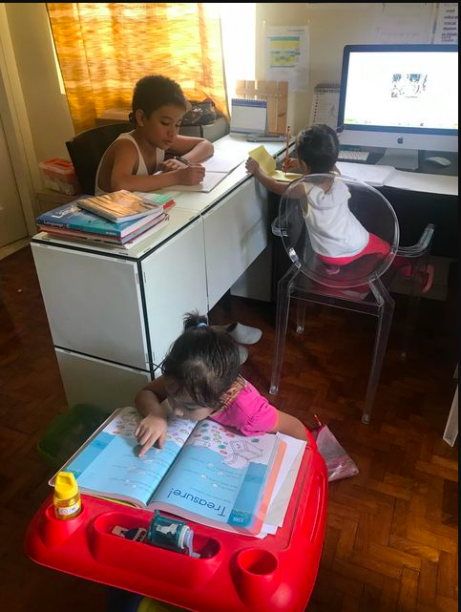 Ces’s three homeschooled kids
Ces’s three homeschooled kids
Journey to Homeschooling
The idea to homeschool her kids was cemented when she and her husband attended a Kids’ expo that featured a homeschool provider. When Ces saw how well the homeschooled kids were performing, she decided to take the plunge. “But here’s the clincher. To homeschool our child, someone had to stay home. At that time, my husband and I were both working, and I practically lived out of a suitcase. In fact, we were so busy that our child, who was 3 years old then, lived with my parents, and we only saw him on weekdays. “
The couple thought hard if their family could survive on a single salary. In the end, they decided to let go of their condo unit and let Ces resign. Her husband worked harder than ever while Ces stayed home to care for their son. “It turned out to be for the best,” she shares. “We couldn’t have a second child because my work was too stressful. When I quit my job, I had two more kids.”
Challenges of Homeschooling
Though homeschool seems ideal, Ces warns that it’s not a bed of roses. “When we started out, it was a constant warzone. My child had already attended school so when I began teaching him, he would go, ‘No, teacher is like this. Teacher is like that.’ And I’d reply, ‘No, I’m your teacher now!’”
Ces, like most mothers of her generation, grew up in a traditional school where students were taught to studiously copy notes and memorize. But since homeschool is closest to the progressive style of education, which is child-led, she had to unlearn a few things. “A decade ago, there weren’t a lot of homeschooling material on social media, so I had to read books on it. I even took up education units.” But Ces clarifies that homeschooling parents don’t have to go this far. “I strongly suggest talking to old-time homeschoolers because no book prepared me for this. Still, you have to understand that each family has its own dynamics. What worked for a successful homeschooling parent might not work for you. So just apply what you can, and as for the rest, be open-minded. There will be challenges, and you have to be flexible. It’s more on being intuitive.”
 Ces dividing her time between her two younger kids
Ces dividing her time between her two younger kids
Benefits of Being Your Child’s Teacher
Pre-pandemic, Ces enjoyed taking family vacations during the off-peak season. “We can even go to museums on weekdays when there are no crowds.”
By teaching her kids, Ces says she gets to know them on a much deeper level. “Homeschooling’s real gift to us is that we get to mold and witness the unfolding of each of our children’s unique character. When I see them interacting with other kids, I take pride that their self-esteem is well-placed, and that they’re not afraid to speak out. We them grow before our very own eyes.”
As to the financial cost of homeschooling, Ces debunks the idea that it’s pricey. “It depends on your diskarte. For the first two years, I had a homeschool provider that gave us everything we needed—books, a curriculum. We just had to submit grades, and that helped us a lot.” But when his son got bored with the books, Ces did her research and found another US-based provider that allowed them to customize the curriculum at one-fifth of the price. “We mixed and matched, and we paid about P25,000 for a school year. If you have a support group, you can share books so you don’t have to buy new ones. At that time, the bulk of our expenses went into enrichment classes—ballet, music, swimming.” But with today’s wealth of online resources, Ces says parents will have no problem honing their kids’ skills. “I know homeschoolers that save a lot of money because everything can be found online for free—even art and dance classes. There are even public-domain books you can download. You can be as frugal—and spend five to ten thousand pesos as year—or expensive as you like.”
Ces admits that homeschool books are costly because they’re shipped from the US. “But they’re expensive for a reason. They’re written in a way that you can use them from kinder to college. So your kids with different grade levels can use the same books.” But even this necessary cost can be whittled down. Aside from borrowing books, Ces saves on online subscriptions by splitting monthly fees and sharing usernames and passwords with other parents. “I want parents to know that you don’t have to spend a lot on homeschool. Whatever your economic status is, it’s doable.”
With homeschooling, Ella finds more freedom in educating her kids. “We get to decide on our kids’ learning pace. We could breeze through topics they’re interested in and spend more time in those they find challenging.”
Birth of Homeschool Momma PH
Ces used to have a blog, which she eventually migrated to Facebook. “It was established mainly to document our homeschooling for our provider. From a personal blog, the page evolved into a platform to encourage other homeschooling parents.”
When the pandemic hit, Ces saw her page likes balloon from 300 to 3,000. “. Some companies have approached me and I always tell them that instead of giving me something, they should give to the homeschool community. My vision for Homeschool Momma PH is for its group members to have benefits such as discounts or special access to education-related things.”
Because of the growing number of homeschoolers, Ces began the private group, the Better Together Support Group. “This was made for the new and accidental homeschoolers because of COVID-19. We do videoconferences to coach and mentor, and share resources.”
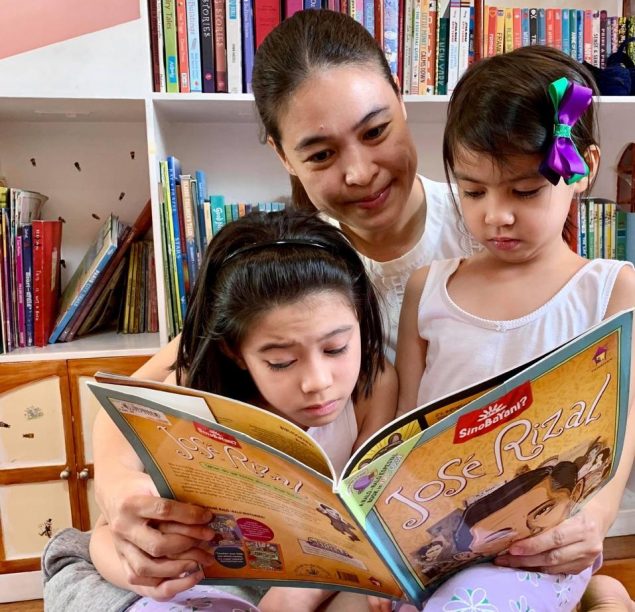 Ella reading to her daughters
Ella reading to her daughters
Homeschooling Tips for Newbies
Perhaps the greatest fear homeschooling parents have is that they’re incapable of teaching their children. Ella echoes this sentiment: “I’m still not sure if we’re doing things right, and if homeschool will work out for us in the long run.” However, Ces puts this fear to rest. “Really, you’ve been homeschooling your children ever since they were inside your tummy. You taught them to walk. We just delegated their education because we thought we couldn’t do it.” She gives these other tips:
Create a schedule— but be flexible.
Ces has an 8th grader, a 1st grader and a three year old. To manage a multi-level homeschool, she tries to allot 1 to 2 hours for each child. Her eldest, who prefers to study on his own, requires the least one-on-one time from her. “I’m more lenient with the younger ones, but I’m strict with my eldest to teach him time management skills.” To maximize time and effort, Ces gathers all her kids for character lessons. When it’s time for PE (Physical Education), she lets them choose the activity. “Sometimes they just go to the playground, and my eldest watches over the little ones, which, in itself, is a life skill. Now that our village has opened its swimming pool for one family at a time, we book it in advance so we can use it.”
Be relaxed, not lax.
“We advocate child-led learning. Some people are concerned about this, but we’ve seen kids who went through child-led learning and grew up to be productive and successful adults.” Ces also employs age-appropriate discipline. “When they’re younger, you allow them to explore and be relaxed. But when they’re moving on to middle school, to high school, then you introduce structure because you’re preparing them for college life.” For Ces, learning comes in many ways. “Try to make it fun for them. It doesn’t have to be pen and paper or books all the time. You can watch movies and then use that as your lesson for the day.”
Know your child’s learning style.
Is your child visual? Auditory? Kinesthetic?. “You can search this on the internet, and take the test to know your child’s learning style. Then you’ll know the best way to teach them—not based on how you were taught. Sometimes you catch yourself saying, ‘When I was your age, I already knew the multiplication table!’ It’s not like that. You have to adjust to your child.”
Make time for yourself.
Because teaching your children is no easy task, Ces stresses the importance of “me time.” “That’s a downside of homeschooling—you have less time for yourself. But my kids know that when 4 P.M. hits, I can’t be bothered. For an hour, at least, I have time to rest and relax.” Doing her morning prayers also equips Ces with the strength to get through the day. “I’ve tested and proven this all these years—when I wake up energetic, my kids are also lively and easier to teach. When I’m downcast, they feel the same. So it’s important to recharge.”
Unplug.
Though Ces runs a Facebook page, she doesn’t spend too much time on social media. “Because if you’re so immersed in social media—researching, joining groups, asking, reading all those posts—you’ll compare yourself and your kids with others. You will question and doubt yourself. It’s best to filter your resources.”
Don’t be too hard on yourself.
“Be forgiving,” advises Ces. “When schedules fail, when your plans fall through, go easy on yourself. If today, you didn’t solve that math problem, tomorrow, you can all be better. Allow for life to happen. Nurturing your relationship with your family is the most important.”
For more resources on homeschooling, check out Homeschool Momma PH on Facebook.
Tsukuba, located in Ibaraki Prefecture, takes its name from Mount Tsukuba, famous for its double peaks. But the city is also popular for the Tsukuba Science City, Japan’s center of research and development first developed in the 1960s. Here, one can find the nation’s top research institutes and two national universities dedicated to various scientific fields such as mechanical engineering, chemical research, and robotics. Tsukuba has also provided both local and foreign governments with data on earthquake safety, environmental degradation and plant genetics among others. With a population of under 300,000, Tsukuba is home to both research facilities and sprawling nature—as well as Julius Santillan, a Filipino engineer.
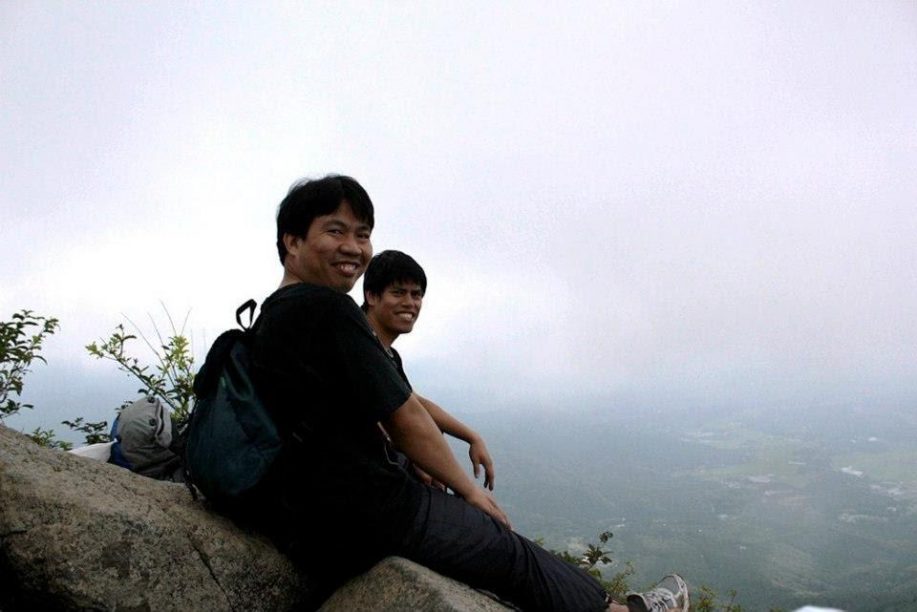 Julius and a friend at the peak of Mt. Tsukuba
Julius and a friend at the peak of Mt. Tsukuba
I was born and bred in Silay City, Negros Occidental—simple life, simple dreams. My father wanted me and my brothers to be engineers because he liked the idea of having the title “engineer” attached to our names. As the eldest of four boys, I felt obliged to fulfill his dream.
I studied at the Technological University of the Philippines (TUP)-Visayas, which had a Japanese Language Program. Our teacher, who was Filipina and studied in Japan, encouraged us to apply for a “Monbusho” Scholarship, an academic scholarship offered by the Japanese Ministry of Education, Culture, Sports, Science and Technology. So, I did and got in.
In 1998, I flew to Japan to study. Here I met Caryn, a fellow scholar and Filipino, who eventually became my wife. In a foreign land, we studied, eventually worked and raised our two sons.
 Photo of Julius featured in a Japanese newspaper
Photo of Julius featured in a Japanese newspaper
Journeying in Japan
After three years of studying in Osaka, I moved to Tokyo to work as an engineer for laser equipment used in eye surgeries among other applications. After a year and a half, I was outsourced in Tsukuba to work on semiconductors so sensitive that I had to wear a suit inside what they called the “super clean room.” This is a room with a strictly-controlled environment that keeps harmful particles (for the semiconductors) at a minimum level. Presently, I’m working for Osaka University but our research allows us to remain here in Tsukuba.
During the first few years working in Tsukuba, my family then was living near Disneyland Tokyo and I’d shuttle back and forth for work. But in 2011, the huge earthquake came and I got stranded in Tsukuba. At that time, Caryn and the kids were in the Philippines on holiday (fortunately) but we decided to relocate to Tsukuba so we could all be together whatever happened. I also thought the good distance from the sea was a plus since we’ll be away from tsunami waves—if ever.
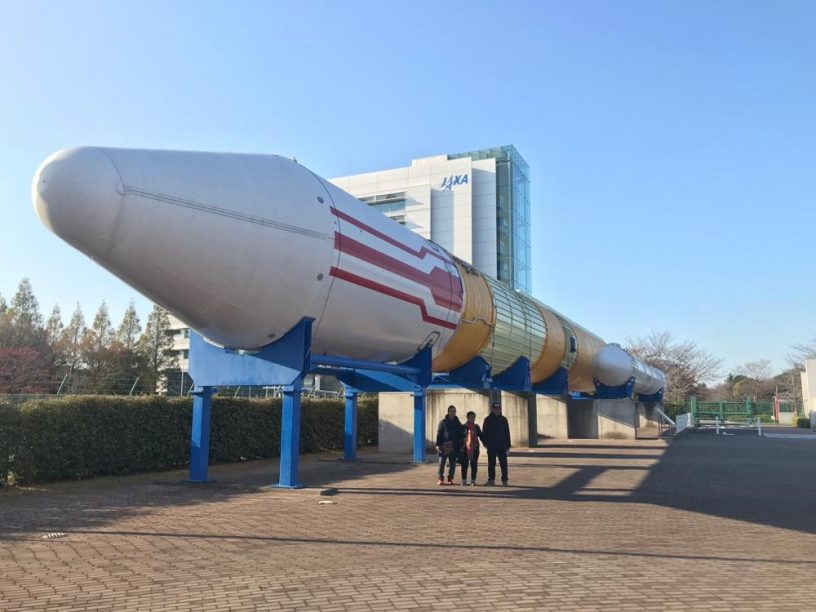 Actual rocket displayed at the Japan Aerospace Exploration Agency in Tsukuba
Actual rocket displayed at the Japan Aerospace Exploration Agency in Tsukuba
Tsukuba, City of Paradox
Walking around in Tsukuba is a bit confusing in the sense that expansive high-end laboratories are sandwiched by sprawling rice fields and vegetable farms. If you want to see a place with both farmlands and robots, this is the place.
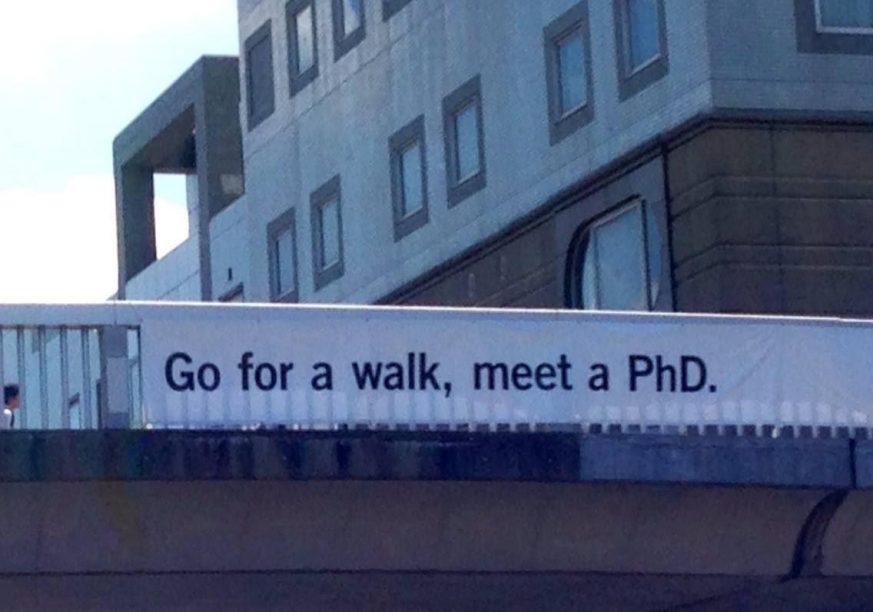
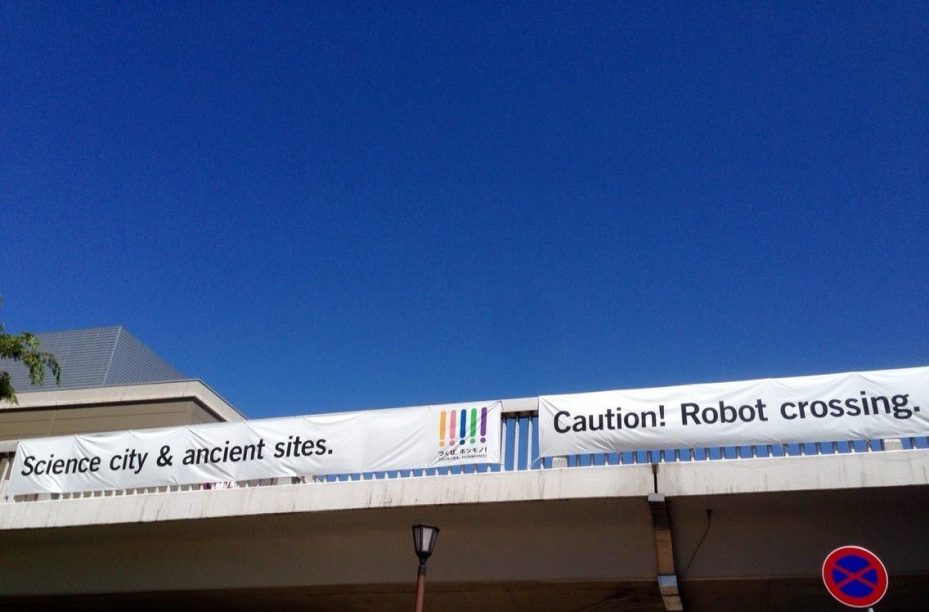 Signages in Tsukuba
Signages in Tsukuba
In this science city with so many research labs, you’ll meet a lot of PhDs (Doctors of Philosophy). Researchers from all over Japan often find work in Tsukuba, which was why the government built a direct train line from here to Tokyo. Tsukuba is a young city with well-thought out city planning. It is very family-friendly (with parks, bike roads, etc.) so it’s only natural that researchers bring their families to make their home here. As a result, more schools were put up here—high-level elementary and high schools that rank in the whole of Japan. In fact, some Tokyo residents bring their kids to Tsukuba for schooling.
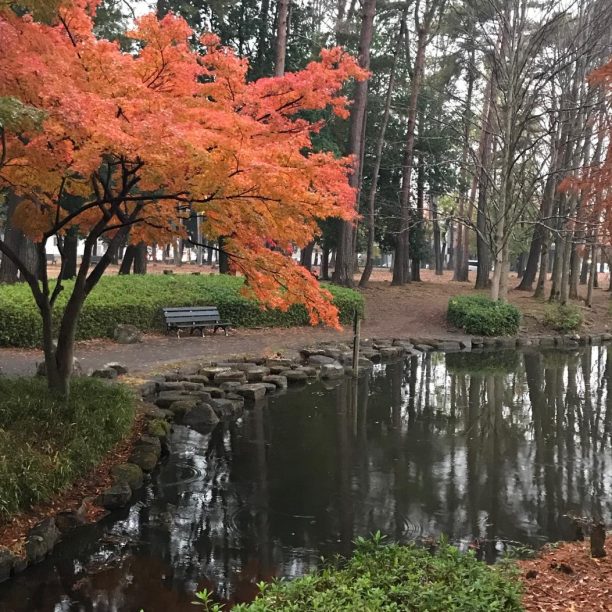 Autumn in Matsuhiro Park
Autumn in Matsuhiro Park
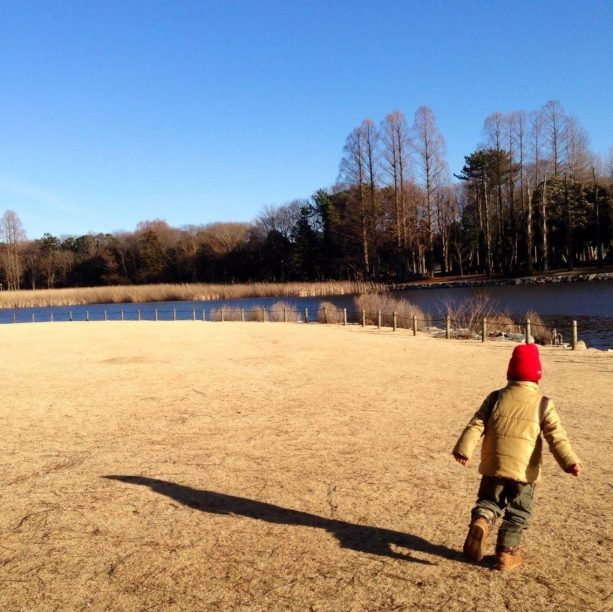 Doho Park
Doho Park
But unlike in Tokyo where supermarkets are a stone’s throw away from my apartment, I have to walk around 10 minutes to buy food—the faster way than taking the bus, which arrives only every 30 minutes. But the parks here are heaven. We’d just go down the apartment and instantly land in the park. There are so many parks here; each community has one. And most of these parks are connected by paths for pedestrians and bikes. If we want to go to the city center, it takes about 25 minutes of walking. But we pass by three parks so the kids get to play in between.
Another interesting tidbit about Tsukuba is it’s hailed as “The Pastry Capital of Japan.” In my neighborhood alone, there are around four bakeries (French, German, Danish, and a Japanese one selling baumkuchen, a traditional German cake). If you want to go on a pastry food tour, it’s best to travel by bike or car as the cafes and bakeries are far from each other. The establishments in Tsukuba, including malls, are usually huge because there’s so much space here.
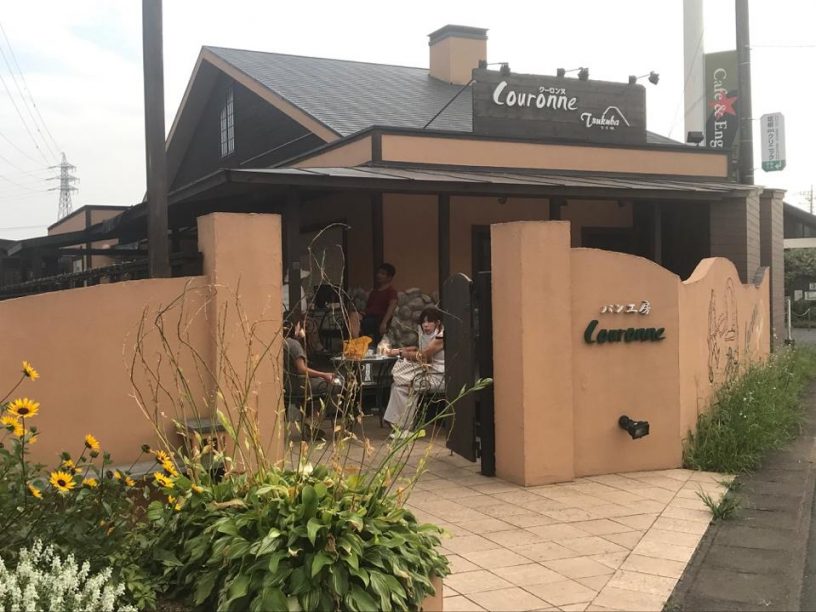 French bakeshop
French bakeshop
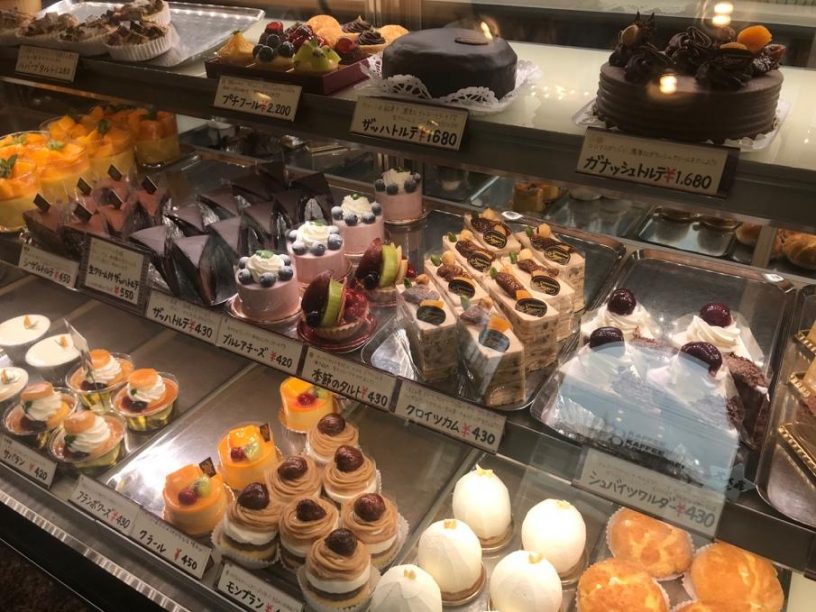 Sweet offerings
Sweet offerings
Away from Family
Caryn and my two boys moved back to the Philippines in 2016 because my eldest son needed therapy. He wasn’t responding well to Japanese teachers, but he was cooperative with his Filipino teachers. So, my wife and I decided it would be best for them to live there, and just visit me once or twice a year.
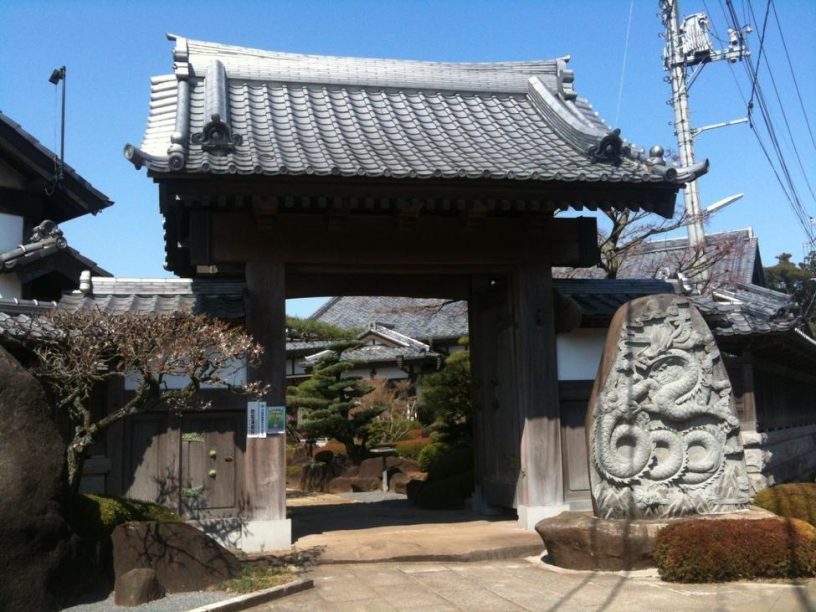 Traditional house
Traditional house
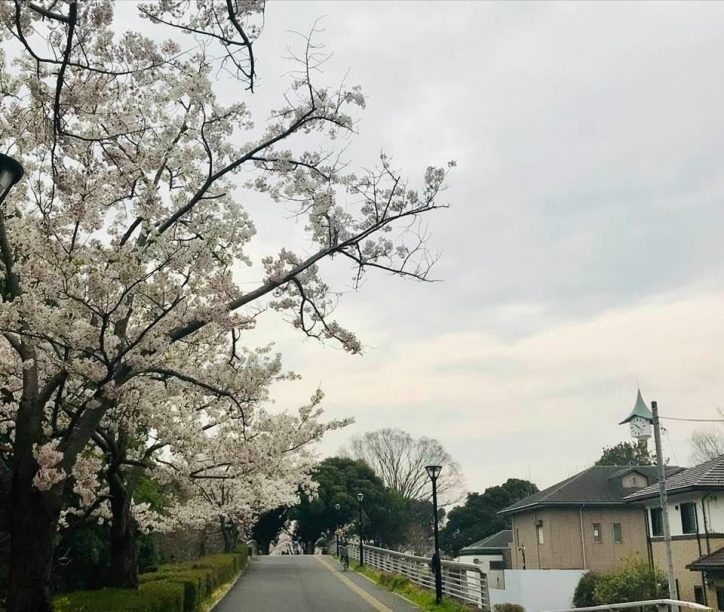 Springtime near Ninomiya Park
Springtime near Ninomiya Park
At first, it was difficult. Tsukuba is a quiet city. Around 10 pm, it’s dead silent here. No industrial noise, no construction— just the hum of electricity in the apartment. It’s so quiet, I hear the buzz of dragonflies outside my window. I can hear myself think—which was scary at first but is not so bad when I got used to it. Although sometimes, thoughts don’t let me sleep.
I try not think too much about being alone. My parents raised me to always make do with what I have. To cope, I decided to further my studies. The Tsukuba University nearby has a program that allowed me to work while studying. In a year, I completed my papers and got my PhD.
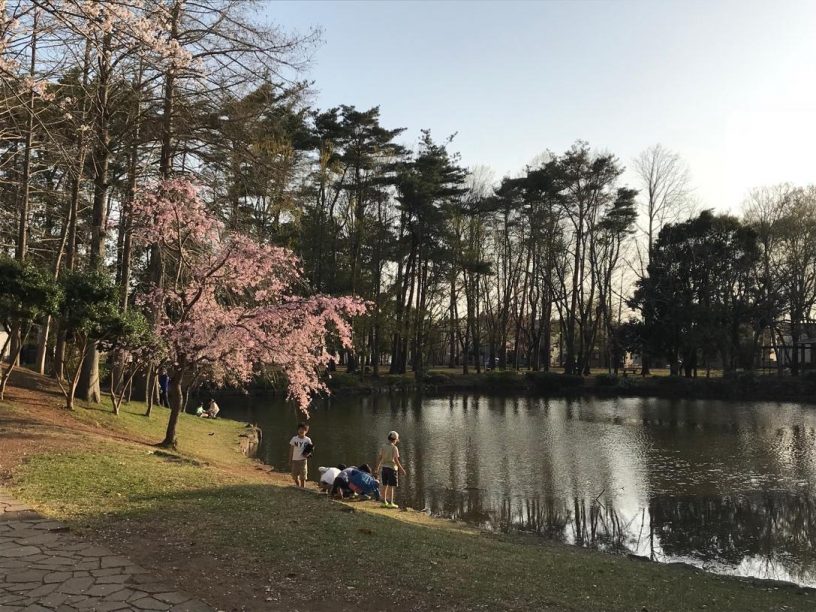 Spring in Matsushiro Park
Spring in Matsushiro Park
The parks, which were my sons’ playground, became my thinking spots. I like reflecting on my present situation and my past self, and marveling at how far I’ve gone.
I’ve also learned to cook. Before, I relied on Caryn to make all the dishes. Now, I’m getting acquainted with ingredients and spices. I’m confident enough to share my cooking when we have potluck parties with other Filipinos.
Music is also an outlet. I compose songs to express myself since I’m not the best in verbally communicating my feelings. I play the guitar, the cajon and bass. I’m also in a band with Pinoys I’ve interacted with—former students, teachers and co-volunteers at the Japanese embassy. At present, we get to collaborate through the internet.
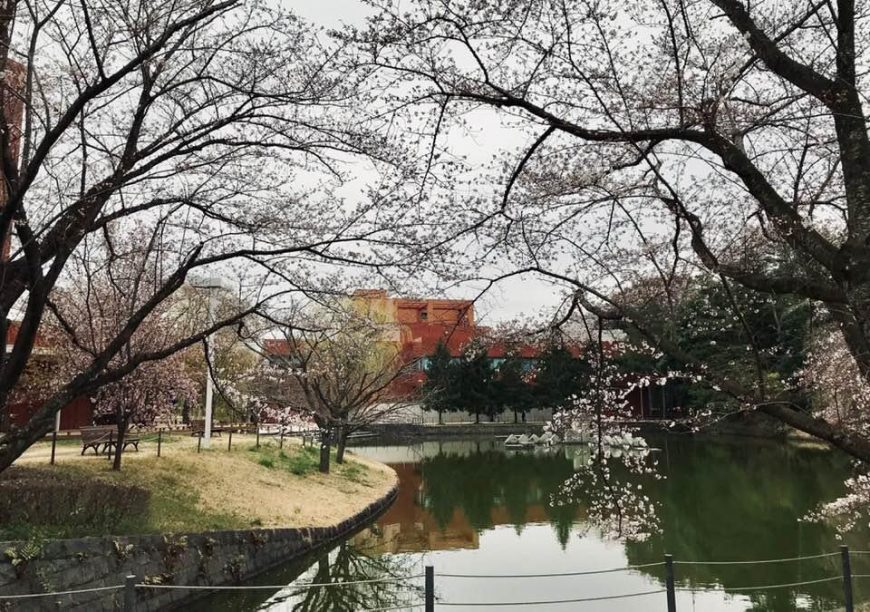 National Institute of Advanced Industrial Science
National Institute of Advanced Industrial Science
Tsukuba and the Pandemic
The pandemic impacted my already limited social life. When Caryn was here, our home was a haven for Pinoy students who wanted a piece of home. My wife would cook for them, and I’d entertain them with jokes. When my family went back to the Philippines, I maintained those friendships, but because of the pandemic, I don’t get to see our friends anymore. Now, my conversations are only with my boss, our engineer, and the people who man the supermarket and convenience store near my apartment!
Seriously though, living in Tsukuba has its advantages during the pandemic. There’s so much space here, so people can practice physical distancing without effort. It’s not like Tokyo where you have to hunch your shoulders to avoid bumping into people. Here, we have abundant personal space. You can walk for several minutes without seeing anyone (I don’t know if that’s a good thing). The parks are so huge, you’ll have no problem finding solitary spaces.
We only have a few cases but since Tsukuba is connected to Tokyo, the place with the greatest number of infections at this time, everyone is cautious. The Japanese government encourages its citizens to install a contact tracing app in their smartphones. If you spend more than 10 minutes talking to someone, your phones leave a record through Bluetooth communication. When the person you’ve talked to tests positive for COVID-19 and registers it through the app, it will contact people he’s interacted with and recommends that they also get tested.
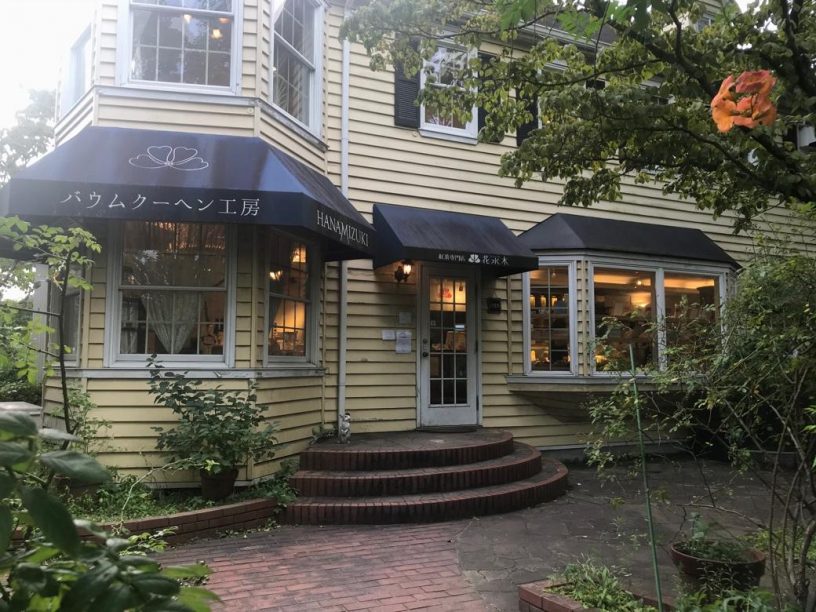 Restaurants remain open during this pandemic though takeouts are highly encouraged.
Restaurants remain open during this pandemic though takeouts are highly encouraged.
Home away from Home
After 22 years of living in Japan, I’ve fully adjusted to the culture. Though the Philippines will always be home to me, Japan has also provided me a nest that gives me comfort. There’s no more language barrier for me. Nihongo may be simple, but also very nuanced. Sometimes, the Japanese don’t say things directly. I’ve learned to read between their lines to understand what they’re not saying but saying—if you know what I mean.
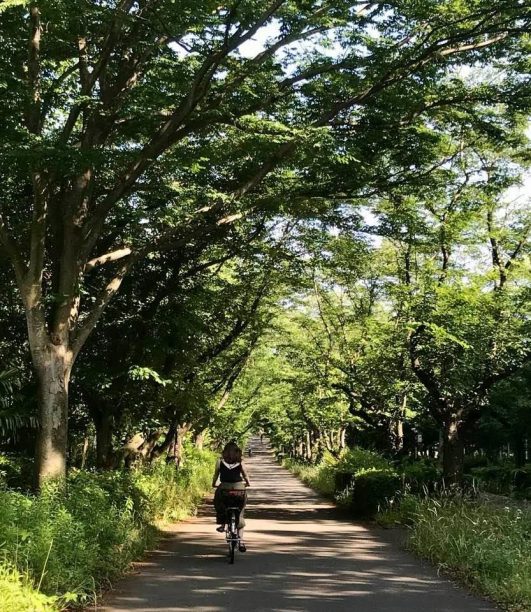 Summertime on the bike path near the Tsukuba International Conference Center
Summertime on the bike path near the Tsukuba International Conference Center
Although I’ve adjusted here, I’d still like to retire in the Philippines. It’s where my family lives, the place I’m most comfortable in.
But for now, I accept my life’s paradox, just like how Tsukuba is a city of both rural farmlands and pioneering scientific breakthroughs. In order to better provide for my family, I need to be away from them. It’s a story all overseas Filipinos share, and an unfolding story, which, I hope and believe, will end happily.

Metro Manila’s first few days under General Community Quarantine (GCQ) saw a deluge of commuters being stranded with no sufficient public transportation. But the urban commuter’s burden has long been an issue even before the pandemic.
Caryn, a resident of Tondo in Manila, recalls a particular incident that stood out in her more than twenty years of commuting. “Once, I was in Pasig when the MRT broke down and we were advised to take the bus across the street. I was so surprised to find out there wasn’t a bus stop. There were no lines—it was a free-for-all kind of thing. People grabbed the railing and pulled themselves up onto the bus, while the conductor kept yelling for people to hurry up because the traffic enforcers were coming.”
Aloy, who’s been commuting since she was twelve and is now a mom, has a collection of horror commuter’s stories. “Around 2003, I was sitting in a taxi in the middle of traffic, painfully aware that I was missing my friend’s wedding to which I was supposed to be the lector. In 2005, when MRT was getting more crowded, I remember being forced to press against a total stranger—male, as luck would have it. In 2016, I was stuck in one of those triple whammy carmageddon nights of floods, mall sale and payday. I was forced to stay over at a friend’s home until 11 p.m. before I could go home to my family, which included a breastfeeding baby. I think about all the time traffic has stolen from me and my family, and I find it unacceptable.”
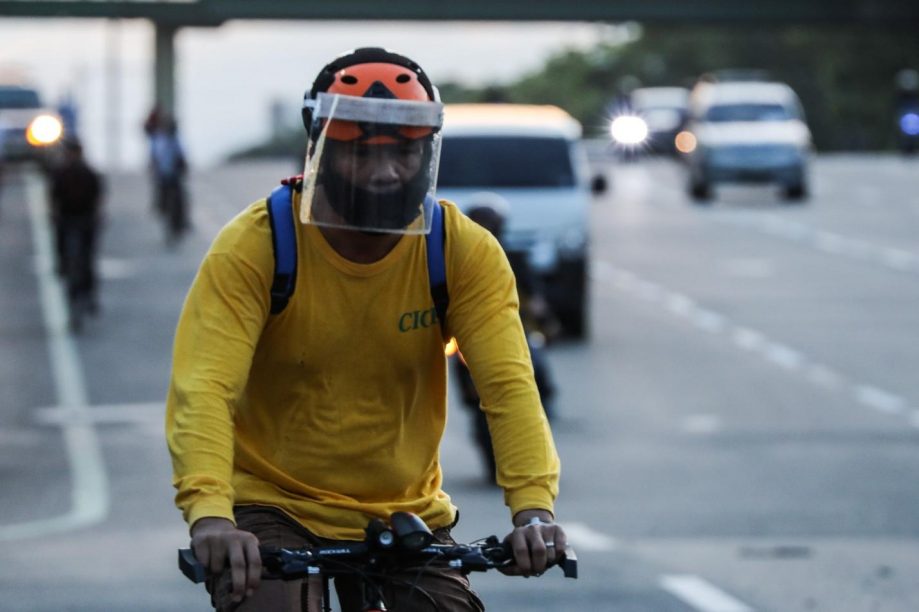 Biker wears a face shield attached to his helmet (Photo by Jire Carreon)
Biker wears a face shield attached to his helmet (Photo by Jire Carreon)
Hitting the road
In 2010, the World Bank noted an increase in energy consumption from the Philippines’ transport division, making up about 37% of the country’s total energy consumption—most of it coming from road transportation.
But with the declaration of the Enhanced Community Quarantine (ECQ) two months ago, people were discouraged from leaving their homes and public transportation was banned, resulting in empty roads. With essential businesses such as hospitals, pharmacies and food markets continuing operations, employees and consumers who didn’t own cars rode bicycles or walked.
Danielle Guillen, an urban transport planner and professorial lecturer at the University of the Philippines Diliman’s School of Urban and Regional Planning and Asian Institute of Tourism, makes this observation: “I think the ECQ showed that active transport is doable in Metro Manila if there are few motorized vehicles on the road. The ECQ really brought back the road space for people. Active transport (biking and walking) is only doable if we have enough road spaces that are connected, safe, and green shared with pedestrians and cyclists. Aside from the hard infrastructure that includes people-friendly designs, the soft infrastructure should be there. This means building the culture where motorists respect pedestrians and cyclists like what we see in most developed countries. This would mean embedding prioritizing transport ethics in our educational and motor vehicle registration systems.”
 Bike and pedestrian paths in Tsukuba, Japan (photo by Caryn Santillan)
Bike and pedestrian paths in Tsukuba, Japan (photo by Caryn Santillan)
 Parked bikes in Amsterdam, Netherlands (photo by Johan Marten)
Parked bikes in Amsterdam, Netherlands (photo by Johan Marten)
How other countries do it
During the quarantine, biking and walking for most people was a novelty. But in other countries, such forms of active transport have always been the norm.
Caryn, who lived in Japan for more than a decade, shares that Tokyo train stations provide overnight parking lots for bicycles so employees could bike from the station to their offices in the morning. “Active transport is very much integrated into their way of life. Very early on, kids are taught to walk to school. They were allowed to use a bicycle to commute when they were old enough. Some bicycles are fitted with attachments for transporting one to two preschoolers, or have baskets for groceries. The bikes have safety features, and need to be registered at the local ward office.”
For seven years, Aloy lived in the Netherlands, where active transport is the default lifestyle with children learning to bike as early as two years old. “Some families even have different kinds of bikes—the everyday, inexpensive one for daily trips to work, errands or visiting friends; and the fancier, sturdier bikes for long-distance weekend trips. There are cargo bikes for carrying your little ones, and e-bikes for older members whose knees are getting weaker.” Because of this, rush hour in the Netherlands looks a lot different from Manila’s carmageddon. “Rush hour in the Netherlands is a swarm of bikes. Bike infrastructure is everywhere. In any party or gathering, I’m guessing that more than 80% of the people came in bikes.”
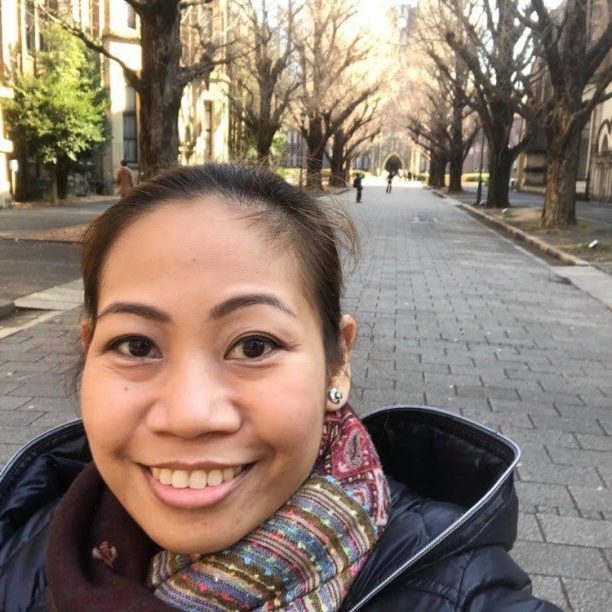 Caryn in Tokyo, Japan
Caryn in Tokyo, Japan
But in both Japan and the Netherlands, bikes are not the only kings of the road. In Japan, non-bikers like Caryn find it a breeze to walk. “Since most sidewalks are wide and clean, walking in Tokyo wasn’t a hardship—even in heels! When we moved to Tsukuba, which is about an hour away from Tokyo on the express train, I usually walked. It takes around 20 minutes for me and my kids to walk to the city center, but the pedestrian and bike paths are clean and very picturesque.”
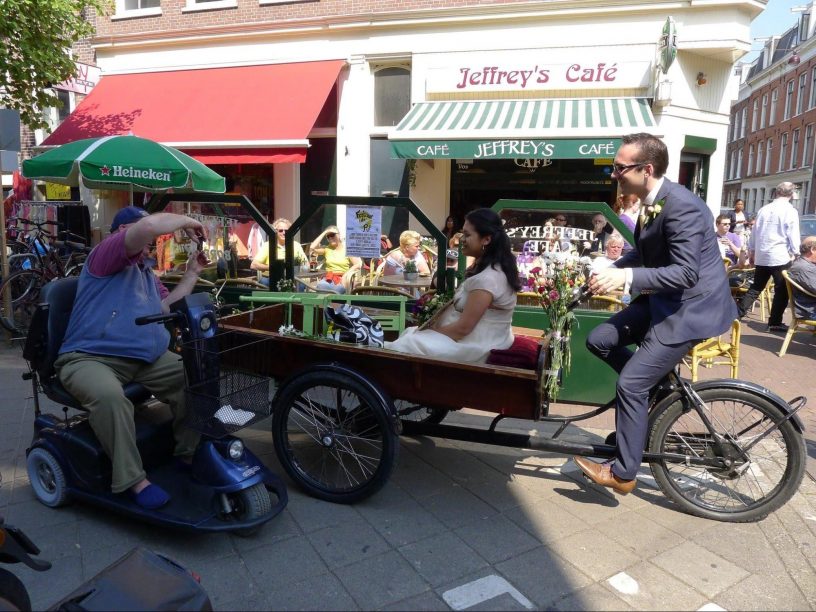 Aloy and Bram rode a cargo bike during their 2011 wedding in Netherlands
Aloy and Bram rode a cargo bike during their 2011 wedding in Netherlands
Aloy shares how the Dutch view walking, not just a means to get somewhere, but also a leisurely social activity. “It helps that there are so many parks. I feel that Dutch cities disincentivize car ownership by keeping roads small, maintaining high taxes on cars, taxis and parking fees, and maintaining bike paths with real barriers and bike stoplights.”
Aside from enabling Filipinos to easily clock in the recommended daily ten thousand steps to maintain good health, active transport also allows commuters greater mobility amid the pandemic. “It is the only means for us to really practice social distancing,” Guillen shares. “Walking is the very first mode of mobility that we could really control. Next is cycling, considered an advanced form of walking. If we have a really good walkway or cycling path infrastructure and space, we can easily estimate if we are two meters away from the others.”
Beyond walking and cycling
Aside from active transport, Guillen acknowledges the need for community public transportation that’s both safe and eco-friendly during the pandemic. “Other forms of public transportation would be busses and trains—as long as the social distancing and related health protocols are enforced. For short-distance trips, single-passenger pedicabs and tricycles are an option. However, it is important to note that the old jeepney does not really meet the public transport utility vehicle design standards. The government’s PUV(Public Utility Vehicle) modernization goal, if I understood it correctly, is to really update in terms of design and make the service meet service-level standards. With the pandemic, design and service should now consider social distancing and related health protocols.”
Even beyond the pandemic, Caryn wishes that the Philippine public transport will be a great equalizer like in Japan. “Train passengers are a mix of teenagers, suited businessmen, mommies pushing baby strollers, kimono-clad old ladies, and women in formal evening wear and fur coats,” recalls Caryn. “There are facilities for the disabled—elevators for wheelchairs, tactile paving, braille signs, and audio announcements (in different languages) for the visually impaired. And I greatly admire the pride instilled in their public transport employees. They all know they are part of an important system that helps the city run. They do their job competently and treat passengers respectfully.”
Aloy describes the Netherlands’ public transport system as a “well-oiled machine. When it falls out of schedule with a delayed train, you can hear the deep, deep disappointment rumbling through the crowd, because they are so used to efficiency. I was once on a train where the conductor apologized over the public system that we were arriving five minutes early at the destination.”
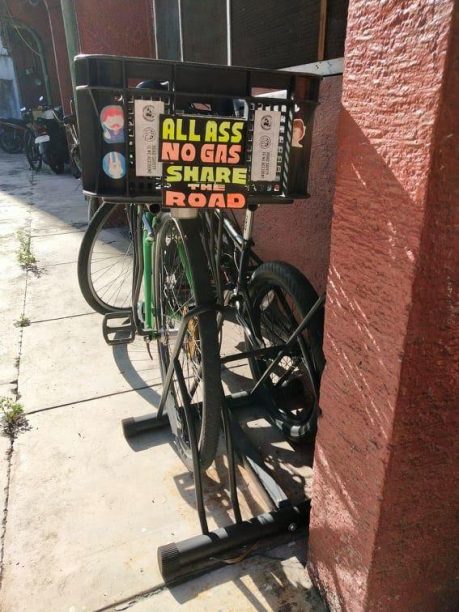 Bike placards (photo by Agay Llanera)
Bike placards (photo by Agay Llanera)
Wishlist for Manila’s public transportation
There is no doubt that the surge of private vehicles in Manila’s roads compound traffic. But why are urban Filipinos so car-centric? Guillen explains, “I think this a product of our long history where building highways was prioritized over the rails, as well as the culture that somehow equate car with economic development. Advertisements to market new vehicles could also play a role. Moreover, there is also the sad reality that public transport and options for active mobility are quite limited. To improve the existing public transport system, there should be enough supply during peak hours and off-peak hours. The system should also consider the active transport component of the whole mobility experience.”
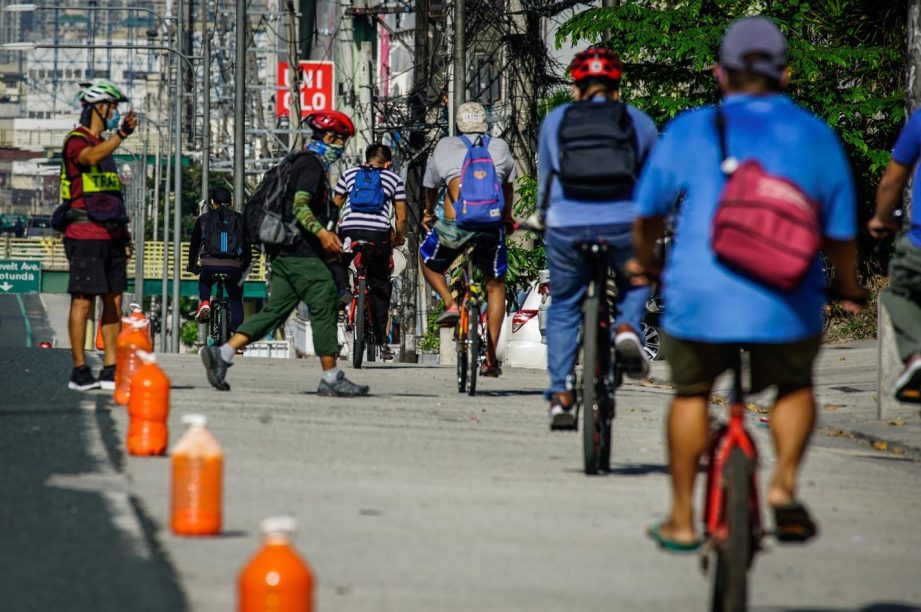 A volunteer assisting bikers during the pandemic (Photo by Jire Carreon)
A volunteer assisting bikers during the pandemic (Photo by Jire Carreon)
Aside from proper bus stops that are strictly followed, Caryn hopes for more waiting areas for commuters, including persons with disabilities (PWDs). “Imagine waiting for a bus under the midday heat or while it’s raining! Also, now that more people are using bicycles, bicycle theft has become a big issue. Establishments should provide secure parking racks— and wider, safer, well-lit sidewalks please, with no vendors taking up the space where people ought to pass. Most of all, I wish we would follow through with urban transport plans despite the changes in administration.”
Aloy wishes for a public transport system that allows commuters to enjoy their travel. “I try to imagine what commuting looks like to a 3-year-old— all 95 centimeters— and it must be frightening. As sociable as we Filipinos are, living in Metro Manila has not made it easy to meet up with friends. If I wanted to enjoy an after-work dinner with a small circle of friends, very few would agree to make it. The city and its transport system simply don’t allow for those connections to be nurtured.”
For Guillen, a country’s public transport system reflects the values of its government and its people. “A country with an exemplary public transportation system means it is a country that truly cares, prioritizing people’s inclusive mobility in the overall system. It is a truly democratic country that provides options to its people on choosing one that truly meets the environment, climate change, and health concerns.”
Plants are the backbone of life on Earth, and are essential sources of food, medicine and shelter. Important as they are, plants can also be a source of fun, especially in do-it-yourself projects.
Until the mid-19th century, plants were the only source of dyes. However, when scientists discovered that they could produce pigments from synthetic chemicals, dyes from plants became somewhat of a lost art.
Today, we’re reviving this art that can be enjoyed by yourself or with family and friends. By using pigments from plants, you save on cost while ensuring that your dye is safe and all natural.
Here are some of the plants that can be used in making your own coloring:



• Avocado and beets for red/pink/purple dye
• Turmeric, onion skin and celery leaves for yellow dye
• Grapes for purple dye
• Spinach for green dye
• Coffee for black/brown dye
• Chili powder & carrots for orange dye
Project #1: Coffee Hair Colorant

Materials:
• 3-4 tbsp of any kind of coffee
• ½ cup of hair conditioner
• Apple Cider Vinegar (optional)
Step 1: Mix the ingredients together until the coffee dissolves.
Step 2: Put a towel around your shoulders to avoid stains.
Step 3: Using a brush, apply the mixture by spreading it evenly on your hair, starting from the roots.
Step 4: After an hour, add 1 cup of apple cider vinegar into the pail of water then rinse your hair, the vinegar helps the hair color lasts longer.
Step 5: Dry your hair and style it.
This dye darkens white and light-colored hair. If you want to achieve a darker tone, repeat the procedure until you get your desired color. But if you don’t like the way your hair color turned out, the coffee will fade after a few washes in the shower.
Project #2: Spinach Fabric Dye
Materials:
• PH-neutral soap
• 8 tsp alum (tawas) per pound of clothing
• Spinach
• Stockings
Step 1: Wash the fabric with the PH-neutral soap.
Step 2: Fill the pot with water then add alum.
Step 3: Fill stockings with spinach and add to the boiling water.
Step 4: You can tie the fabric with rubber bands for a tie-dye design. Add it to the boiling water and let it simmer until desired color is reached.
With the help of PH-neutral soap and alum, the green color lasts longer. To keep the color from fading, use gentle soap when washing your fabric.
Project #3: Paint it Hot Pink!

Materials:
• Egg
• 1tsp vinegar
• 1stp water
• 1tbsp sugar
• Pigment (beets extract)
Step 1: To make your hot pink dye, separate the egg yolk from the white.
Step 2: Mix the the egg yolk with a bit of water, sugar, and vinegar.
Step 3: Add the beets extract (you can get this from by the beets) for the pink color finish.
Step 4: Mix all the ingredients until reached the expected texture of the paint.
Step 5: Pour it in a mini jar for a cute presentation.
You can use this on paper, wood and even bricks! Because of the egg, the paint will smell a little.
But after a few days, the smell will go away.
Try this project at home and make it a bonding activity with your family. When you experiment, that’s where the fun comes out!
By: Panahon.TV Intern – Beatrice Hernandez
Nutrition Month is a health awareness campaign held every July. It came into being when former President Ferdinand Marcos signed Presidential Decree No. 491 (Nutrition Act of the Philippines) on June 25, 1974, creating the National Nutrition Council to promote good nutrition.
This year’s theme is “Healthy diet, gawing habit for life”, which includes the following components:
- Reduction of obesity
- Prevention of malnutrition
- Helping Filipinos distinguish between healthy and unhealthy foods

Fighting Obesity and Being Overweight
Excess weight occurs when a person has accumulated excess body fat. Since 1980, worldwide obesity has nearly doubled. In 2008, more than 1.4 billion adults were considered overweight. According to the United Nations Food and Agriculture Organization (FAO), the Philippines is one of the developing countries with high levels of obesity. A survey conducted last 2011 showed that 22.3% of Filipino adults are overweight and 6.1 percent are obese.

Why do people become obese?
Consuming too many calories. The energy value of food is measured in units called calories. When we eat and drink, we put energy into our bodies. But eating too many calories and not burning enough of them can lead to weight gain.
Consumption of processed or fast food. Such foods that are high in fat and sugar may appeal to our taste buds, but are detrimental to health. They make you pile on the pounds, but not on the nutrition.
Lack of Physical Activity. People need to exercise to burn excess fat, improve muscle tone, boost energy, and naturally increase your body’s production of the human growth hormone.

Why do people become Overweight?
Excessive food intake that aren’t burned turn into extra pounds. But other factors that aren’t related to diet and a sedentary lifestyle can also cause you to be overweight. Here are some of them:
- According to the archived journals of Disease in Childhood, babies of mothers who smoked during their pregnancy are 48% percent more likely to be overweight. Dr. Stephen Weng of the UK Center for Tobacco Control Studies at the University of Nottingham said that the risk may be because of the poor lifestyle and behavior that many smokers possess. Breastfeeding may help reduce the risk of babies becoming overweight, but babies born to women who smoked weighed less at birth and were breastfed for a shorter period of time.
- Stress is an indirect factor of weight gain. Nutritionist Rita Gatchalian says that when people are stressed, they tend to overeat. This is because the stress hormone cortisol increases one’s appetite. Lack of sleep, also a stressor, may also cause weight gain.

- Some medicines can slow down the rate at which your body burns calories and may increase your appetite or cause your body to hold on to extra water.
- Antidepressants can increase cravings for carbohydrates.
- Steroids tend to cause insomnia, increased appetite and water retention.
- Beta blockers and angiotensin-receptor blockers which lower blood pressure and prevent migraine respectively, slow down metabolism.
Obesity Vs. Overweight
Obesity is a hundred percent increase of the normal weight for one’s body type, while being overweight is 50% higher than the normal weight. Being obese and overweight can lead to diabetes, high blood, and hypertension.
Can an overweight person be malnourished?
Malnutrition or “bad nutrition” is a state in which a deficiency, excess or imbalance of the essential parts of a healthy diet cause measurable effects on body tissue.
Through the years, the term has been associated to people who don’t have enough to eat—people whose bones stick out from their narrow frames. But today, malnourishment has a new face. Overweight people can still be malnourished if they eat foods that don’t have the proper nutrients.
To make sure you are eating a well-balanced diet, remember the following:
- Nothing good comes from eating sugar.
- Avoid too much sodium.
- Protein is good for our body but take note that eating large amounts of protein inhibit the proper functioning of our digestive system.
- Good carbs such as fruits, vegetables, oatmeal, and whole grain can help lower blood cholesterol and heart disease.
- Bad carbs are foods that contain almost no nutrients and are high in sugar. Soft drinks, cakes and ice cream are examples of bad carbs.

The Importance of good Nutrition
Food provides our bodies with energy and nutrients so we can live, grow, and function properly. They can protect us from diseases like heart disease, diabetes and cancer. Eating nutritious foods like fruits, vegetables and whole grains will help you maintain a healthy body weight. It can also delay the effects of aging, and can positively affect your mood and increase focus.
By Panahon TV Intern- Darlene Joy Lodronio
